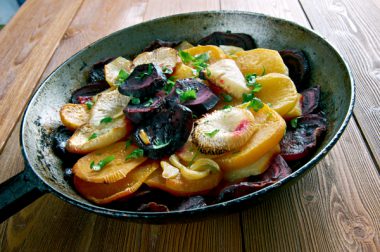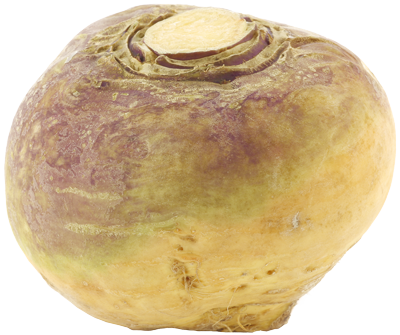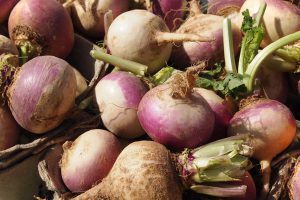Recipes we love
See all recipesRutabaga puree
Rutabaga has to cook for longer than potato. The cooking juice is light and tasty. Underneath its ru...
Rutabagas with carrots and pistachio
This two-colour recipe is a hit with children, who love its slightly sweet taste. A good way to pers...
Health
benefits
A vegetable that’s worth a new look
Famous for having prevented famine in times of war, today rutabagas are well-liked for their delicate flesh. Their fiber content contributes to regular bowel movements, and they are a natural diuretic. In addition, they are low in calories.
Rutabagas are also:
- a source of potassium (for the nervous system, muscular function, and blood pressure)
- a source of vitamin C (for the immune system, collagen formation, energy, the nervous system, iron absorption, and fatigue reduction)
They also contain:
- vitamin B9
- vitamin B1
- manganese
- glucosinolates (cancer-fighting compounds)
Nutritional
composition
When is the right
time to eat them?
Fall and winter
Rutabagas are the ultimate winter vegetable. They are in season from October to March.
Vegetable patch or
urban balcony?
Rutabagas (Brassina napus var. napobrassica, from the Brassicaceae family) grow well in wet, well-drained soil rich in humus, as well as in full sun or partial shade.
Rutabagas are shaped like large turnips. Their skin and flesh are yellowish and sometimes white. They have a strong flavor and a slightly earthy smell. This fall vegetable can tolerate light frosts, which actually enhance its flavor.
To learn everything you need to know about growing rutabagas, read the page on growing advice.
Choosing and
storing arugula
Choosing your rutabagas well:
- They must be firm, dense and pure in color.
- Smaller ones are less hard and tastier.
Storing your rutabagas well:
- In the refrigerator: One week in the vegetable drawer.
Tips and
tricks
How to prepare rutabagas
As with turnips or potatoes, they only need to be peeled.
Rutabagas go well with…
They are easy to work with and can be cooked like potatoes: puréed, fried, oven-cooked, roasted, sautéed, used in croquettes, etc.
Cooked: They are most often eaten in vegetable soups, but they can also be eaten on their own, as a side to a meat dish for example. A classic French dish, pot-au-feu is always prepared with rutabaga (or turnips) to enhance its aromatic composition. Rutabaga gratin is likewise delicious.
Can everyone
eat it?

Young children
Children can try them starting at 12 months. Their bitterness can be slightly reduced by adding a little sugar during cooking.
And everyone else
People with irritable bowel syndrome may experience discomfort when eating rutabaga. This is generally short-lived, and rutabaga may be gradually re-introduced when symptoms are light or during remission.
See plenty of other tips for encouraging children to eat vegetables
Where do they come from?
Origins and varieties
Origins: Rutabaga is produced in Scandinavian countries, Germany, the Netherlands, Canada and the United States.
Varieties: The term “rutabaga” stems from the Swedish rottabaggar, which translates to “cabbage turnip”. In Quebec, this vegetable is sometimes called “chou de Siam” (Siam cabbage), an old term formerly used in France and thought to have preceded its current name, since it is listed in the 1798 dictionary of the Académie française. It is also often confused with the turnip. However, rutabagas differ from turnips in color, flavor, shape and tops.
It would appear that rutabaga originated from a cross between a member of the cabbage family, possibly a kale and a turnip (hence the name cabbage-turnip it is sometimes given). This hybrid likely occurred in Scandinavia, as the first specimen was discovered there in the late Middle Ages. It was not mentioned in print until 1620, when a Swiss botanist described it in detail.
There are white varieties, purplish varieties with white flesh, and yellow varieties with yellow flesh, which have the finest taste.



 Lentils
Lentils  Borlotti beans
Borlotti beans  Vegetable garden: growing soy bean
Vegetable garden: growing soy bean 










